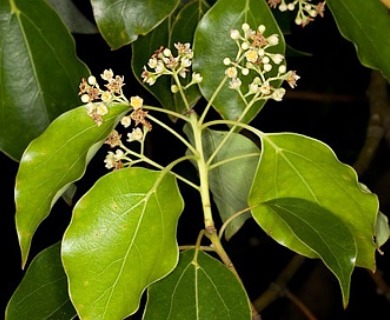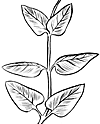Camphor Tree
Cinnamomum camphora
Bay/Avocado family (Lauraceae)
Post-Cook introduction
Medium-sized to large introduced ornamental tree with dense rounded of three-veined shiny dark green leaves and distinctive odor of camphor in crushed foliage. To 80 ft (24 ) high and 3 ft (0.9 ) in trunk diameter. Bark gray, smoothish, becoming thick, rough, and furrowed. Inner bark is pinkish, spicy and bitter. Twigs slender, greenish, hairless. End buds enlarged, elliptical, pointed, 1⁄4 inch (6 ) long, brownish, composed of many rounded overlapping which form rings of scars on twigs upon shedding.

©2006 John R. Gwaltney, Southeastern Flora
Flower clusters () on slender stalks at leaf bases, 1 1⁄2–3 inches (4–7.5 ) long, branched. Flowers, several, yellowish, small, 1⁄8 inch (3 ) long and broad, composed of six- nine and with rounded and short
() 3⁄8 inch (1 ) in diameter, green to black, with short greenish cuplike base and enlarged stalk, the thin flesh with spicy taste of camphor. Seed single, nearly 1⁄4 inch (6 ) in diameter, dark brown.
The wood is yellowish brown with darker streaks, lightweight ( gr. 0.45), soft, fine-textured, strongly scented, and takes a good polish. Elsewhere, it has served in cabinet work, especially chests, because the odor is an insect repellent. A few trees have been cut in Hawaii and worked into chests and closet lining. Camphor gum and oil, used in medicine and industry, are prepared by steam distillation of leaf clippings and wood from plantations.
Planted as an ornamental and shade tree in Hawaii; elsewhere as windbreaks and hedges. On Oahu, Kauai, Lanai, and Maui, a total of 3600 trees are recorded as having been planted in the Forest Reserves. In several wet forest areas, notably in Nuuanu Valley, dense thickets of this tree form an understory beneath Eucalyptus stands. It attains large size when grown as a plantation tree in the forest. There is a stand at about 1100 ft (335 ) elevation along Tantalus Drive, Oahu, that attests to this.
Grown in subtropical regions of the southern continental United States from Florida to southern Texas along the Gulf, and in California, it has escaped and is recorded as naturalized. Uncommon in Puerto Rico and Virgin Islands.
Special areas
Foster, Tantalus
Champion
Height 83 ft (25.3 ), c.b.h. 22.7 ft (6.9 ), spread 100 ft (30.5 ). Ulupalakua, Maui (1968).
Range
Native of tropical Asia from eastern China to Vietnam, Taiwan, and Japan, and widely planted in tropical and subtropical regions.
Other common names
Japanese camphor-tree; alcanfor (Spanish)









